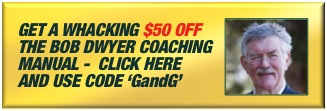In Dwyer’s View this week, I hope I left no doubt about my opinion of the dreadful quality of the Wallabies’ attack. Our cross-field running was atrocious. It’s rarely good, but this was pretty well our worst ever. In this analysis I’ve looked at one incident early in the match, where a Wallaby try was definitely a possibility with quality attack.
[youtube]http://www.youtube.com/watch?v=Fyuu6s2pXfo[/youtube]
Actually, the early part of this passage was reasonable, with some good tight play, parallel to touch; then a pick-and-go, an off-load and a quick recycle. We achieved excellent space with numbers, but then it all went horribly wrong.
The All Blacks, on the other hand, showed an exemplary understanding of realignment in defence and of slide defence. Their quality technique won the day over our absence of quality technique. Funny that!
Stephen Moore, my Wallabies man-of-the-match, picks-and-goes straight ahead and there is good initial urgency in the support play, with Horwill, Genia, Pocock and Alexander looking likely to provide back-up. Moore off-loads to Horwill (I would have liked better body position and acceleration from Horwill, but beggars can’t be choosers) and play continues with promise. Genia holds back for the scrum-half role; Pocock should be showing more urgency and Alexander changes his line to totally avoid the contact (where he is going and what he is doing, I have no idea). Pocock assists in the quick recycle and a try is in the offing.
Kurtley Beale gets his involvement off on completely the wrong foot by aligning miles too wide and deep, and he runs across the field. Then, in an example of his worst-ever performance, Quade Cooper sets off to complete the destruction of the opportunity. Even with the dreadful lead-up work, had he given the ball to Digby Ioane (who was next in line) we would still have scored. It would have been Ioane versus Mealamu, with Sekope Kepu (I have no idea, either, what he thought that he was doing, wandering around out there) in support and Rocky Elsom out wide.
If we could start again we would have had Beale tucked in tighter, running at the defence and asking questions. This would have pulled Cooper in, also asking questions. On the natural loop, Beale then gets the ball back from Cooper, with Ioane and Elsom outside him and Kepu chasing in support. Result – easy try! (Kepu is no slouch with the ball either. I once saw him skin Clyde Rathbone with an in-and-away in a 30-metre run to the tryline.) One classic and obvious way to make the drift difficult is to throw in a loop, or at least the possibility of a loop.
None of this is in any way physically difficult, by the way. In my description above, until Beale gets his second touch we have not even reached the defence. We’ve only forced them to operate, or at least to think about operating, parallel to touch.
Let me quote some of the demands of my Coaching Manual that apply to the scenarios discussed above:
We must engage defenders and move the ball away to attack the spaces left unguarded, aggressively and urgently, with power or finesse, or both. Any delay will allow defences to realign. Remember to attack all of the spaces – in tight, on the edges, in mid-field, or out wide – as the idea suits you. They will be found missing before long.
We weren’t too bad here, although I’m not too sure that we were engaging them ‘aggressively and urgently’.
For attacking backline play, I say that the first receiver must not be
…too wide – you don’t want to give the defender an angle on to your outside backs – and not too deep – unless wanting to clear your line. Give the opposition close defender the impression that he can get to you. Start asking questions immediately.
And for the second receiver:
Your role is to generate pace and direction to the attack. Create urgency in the minds of the defence by the acceleration of your attack. […] The key role of the attack is to ask questions at the source of the drift, i.e. the area between the (recycled ball) and the first receiver.
The All Blacks, needing to drift to cover the shortage of numbers in defence, were actually invited to fill the space between the recycled ball and the first and second receiver by the angled runs of both Beale and Cooper. This allowed Franks and Carter to push the outside defenders across, right from the first pass. Carter, who had a great game in defence, actually got across field about 40 metres to assist in the Elsom tackle. It was only a foot race, after all, as not one question was ever posed that could have caused him to change angle or pace!


